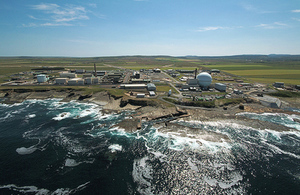Reactor decommissioning demonstrates new approach to bulk waste disposal
Dounreay’s highly active fuel examination cave is the first structure on site to be removed using the Babcock Dounreay Partnership’s bulk approach to waste disposal.

Dounreay
The NDA’s chairman Stephen Henwood stood in the cleaned-up post-irradiation examination cave and said: “I’ve visited this facility a few times during the decommissioning and I am always impressed by the progress which has been made since my last visit.
“The pace of this work and the fact it has been achieved in a safe and secure manner testifies to the ability and commitment of the DSRL work force and its supply chain partners.”
The cave is part of the suite of buildings serving Dounreay’s first reactor, which is scheduled for demolition shortly. It was used to inspect irradiated components from DMTR and later PFR
The clean-up of the ancillary buildings is also nearing completion, and major items of redundant equipment are being taken apart or removed whole for bulk disposal.
The cave’s two 26-tonne maintenance area shield doors were lifted out through the roof of the building in June.
After the highly active waste was removed and the structure of the cave was cleaned up remotely, a team of clean-up specialists decontaminated the doors before attaching them to a specially designed steel frame. They opened the building’s roof hatch so that the doors could be lifted out through the roof hatch by a mobile crane.
The work paves the way for the PIE cave to be dismantled as part of the final stages of clean-up of the active handling bay.
The concrete structure will be cut into large blocks using diamond wire cutting equipment, before being removed from the building and transported to a temporary waste store, pending final disposal in the new low level waste facility being constructed at the site.
The cave will be the first structure to demonstrate the Babcock Dounreay Partnership’s bulk approach to waste disposal.
Project Director for the FCA, Steve Beckitt, hailed the decommissioning of the PIE cave as a “significant achievement”.
“This was a legacy facility that had been left under minimal care and maintenance, with a highly radioactive inventory, large waste volumes and defunct plant/equipment,” he explained.
“The success of the project is due to the professional approach of the team doing the work, who had to apply innovative solutions in order to solve difficult engineering problems, with safety a key aspect of the work.
“The knowledge, experience and skills gained by the team on this project will be useful to other projects in the FCA or site in general.”
This innovative approach to decommissioning will be used site wide on structures such as caves and cells. Babcock Dounreay Partnership intend to broaden the approach to include whole facilities, such as the Dounreay Materials Test Reactor.